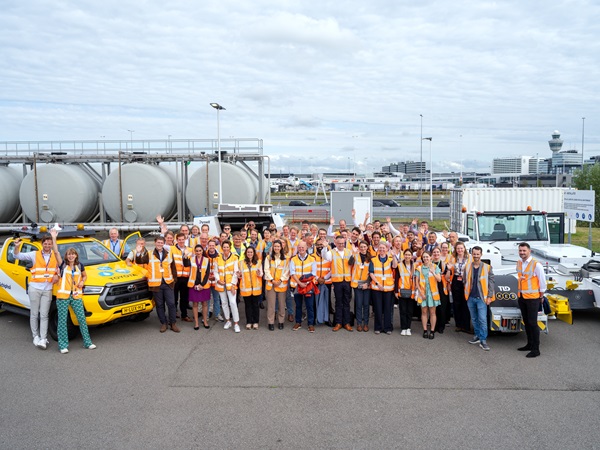September 2025
On Monday 8 September, TULIPS offered an exclusive first look at two groundbreaking innovations now in active use at Amsterdam Airport Schiphol: the hydrogen-electric tow truck and the hydrogen refuelling station, both located on the J-platform. This marks a major milestone for the Workpackage 4 team, led by Fraunhofer, who have worked tirelessly over the past years to bring these innovations to life. It’s also a significant step towards zero-emission ground handling and cleaner air on the apron.
A Day Dedicated to Hydrogen
There was strong interest in the TULIPS update on hydrogen progress—an engaging topic not only for the partners involved, but also for other airlines and government bodies such as regulators. The goal was not only to celebrate the success but also but also to share knowledge. It’s clear that many hurdles have already been overcome in the lead-up to this demonstration, and valuable experience has been gained.


Insights from the Field
TULIPS partner KES (ground support equipment (GSE) operator at Schiphol) shared its experiences with the permitting process, risk assessments, and certification requirements. They also spoke about the technical integration and staff training. Operators are enthusiastic about driving the hydrogen tow truck, describing it as smooth and responsive.
Design Challenges and Innovation
Supplier TLD shared their perspective on integrating a single electric driveline with multiple power sources, enabling a smoother transition to sustainable alternatives. They also provided insights into the performance differences between battery-electric and hydrogen-electric vehicles. Refuelling takes just 10 minutes, and the hydrogen-powered tow truck can perform up to 90 pushbacks on a single refuelling—significantly more than its battery-electric counterpart.


Hydrogen in a Broader Context
Schiphol Group, KLM, and Rotterdam The Hague Airport placed hydrogen developments within a wider context during their presentations. Schiphol Group highlighted the unique opportunities the Netherlands offers for hydrogen infrastructure, including its ports and the Gasunie network. Without infrastructure, hydrogen cannot be deployed at airports. This also linked to other EU hydrogen projects, such as GOLIAT, which aims to enable widespread use of hydrogen at airports.
KLM emphasised the importance of partnerships and exploring and developing multiple sustainability solutions in parallel—hydrogen, fleet renewal, and sustainable aviation fuel (SAF) all play a role. Rotterdam The Hague Airport discussed both gaseous and liquid hydrogen, focusing on storage on airport grounds and operational aspects of hydrogen-powered aircraft. They are planning a follow-up to the NLR hydrogen drone demonstration for later this year, another TULIPS demo.


Collaboration Is Key
One message resonated clearly among all partners: innovation cannot happen in isolation. Collaboration across the entire chain is essential. EU programmes like TULIPS are therefore invaluable, and EU funding provides a crucial boost to help make airport and aviation more sustainable a reality.
A Close-Up Look at Hydrogen Equipment
The event concluded with a visit to the airside area, where attendees could view the hydrogen refuelling station, the hydrogen electric tow truck, the hydrogen electric GPU (now back at Schiphol), and a hydrogen-powered Toyota pickup. In the coming weeks, these will be used in the operation at Schiphol. The findings are shared from the TULIPS programme.








